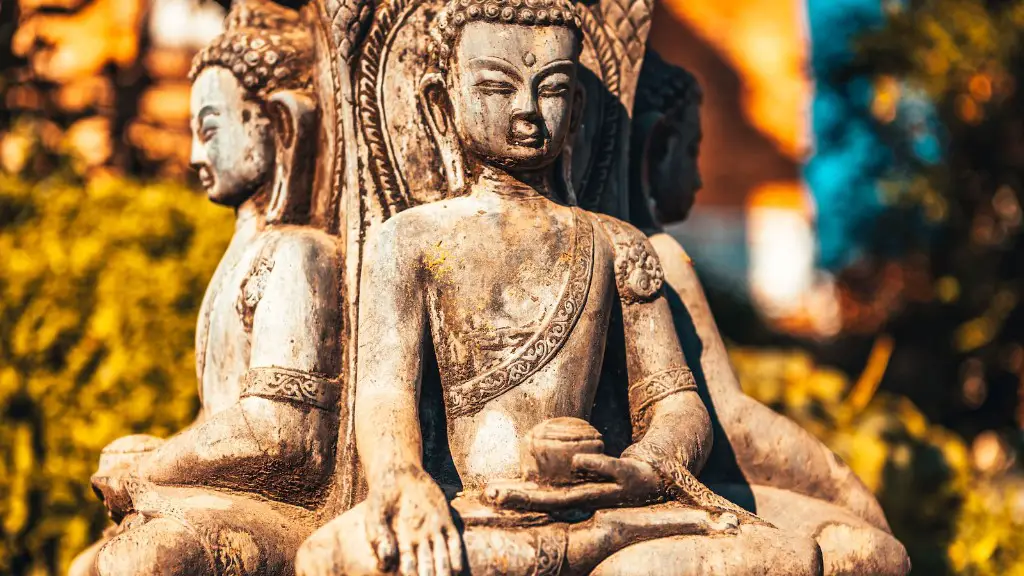Shiva is one of the most important deities in Hinduism. He is portrayed as a fierce god with immense power, but also as a compassionate being with divine healing abilities. He is sometimes referred to as the Destroyer, as he is said to have the power to destroy the universe and all its inhabitants upon his will. He is also known as the Creator, as he creates life through his grace. Shiva is a complex figure with many different forms, symbols, and meanings. To truly understand who Shiva is in Hinduism, one must explore his roles, aspects, and the different religious narratives.
In Hindu mythology, Shiva is one of the three primary gods, along with Brahma and Vishnu. Shiva is usually portrayed as having a blue throat and four arms. He is said to reside at Mount Kailash, a sacred mountain in the Himalayas. Shivā is often associated with a variety of weapons, including a trident and a drum, but also with gentle practices such as yoga or dance. Shiva is worshiped as the Supreme Being, embodying the qualities of all three primary gods.
Shiva is said to be the destroyer of ignorance, and is honored as the god of the creative force in the universe. He is often portrayed as being detached from worldly matters and sitting in deep meditation, on a tiger skin. Shiva is seen as having unlimited divine power, and is described as a being beyond time and space. He is associated with a deep spiritual power, and it is believed that he can grant enlightenment to those who seek it.
One of the most consistent aspects of Shiva’s character is his association with death and destruction. Shiva is often referred to as the god of death, and is credited with controlling the cycle of life and death. He is also the god of transformation, and is said to have the power to transform anything into its opposite. This duality can also be seen in his association with fertility and also with his fierce ferocity.
Shiva is also associated with fertility and abundance. He is a symbol of fertility and creativity and is said to have the power to bring everything to life. He is often associated with the seasonal cycles and is believed to bring abundance and prosperity. Shiva is often seen as the god of fertility, but he is also associated with asceticism and celibacy.
Another important aspect of Shiva is his association with the concept of karma. Shiva is often portrayed as a teacher who instructs his devotees on the right path and teaches them the importance of living according to the laws of karma. Shiva is said to guide and protect those who follow his teachings.
Shiva is also associated with asceticism and renunciation. He is said to have renounced all worldly desires and to have taken a vow of silence, which explains why he is often portrayed in a meditative stance. Shiva is seen as a powerful teacher and is said to give his devotees spiritual guidance and insight into the nature of reality.
Shiva’s Attributes and Symbolism
Shiva is often depicted in various forms, each of which conveys a different message. One of his most recognizable forms is the Nataraj, or “Lord of the Dance.” This form of Shiva is said to represent the cycle of life, death, and rebirth. Shiva’s consort, Parvati, is often depicted accompanying him in this form.
The trident is one of Shiva’s most prominent symbols. It is said to represent his three roles as creator, preserver, and destroyer. Shiva’s third eye is also a key symbol, and is said to represent his wisdom and insight into the truth of the universe. The snake, or nāgas, is another important symbol associated with Shiva, and is said to represent the idea of the continuity of life, even in the face of death and destruction.
Shiva in Modern Hinduism
Shiva remains a popular and widely-revered figure in modern Hinduism. He is considered to be both a powerful and compassionate deity. Many people pray to him for help and guidance, and many temples and shrines are dedicated to him throughout India. Shiva is also widely venerated in other parts of the world, such as India’s subcontinent and in countries such as Nepal, Thailand, and Bhutan.
In modern Hinduism, Shiva is seen as an embodiment of the divine masculine energy. He is viewed as a symbol of strength and power, and is venerated by many people around the world. He is often depicted in artwork and ritualistic practices, and his presence can be felt throughout India. Shiva’s role in Hinduism has also changed over time, as new interpretations and adaptations of his role have emerged.
Shiva in Other Religions
Shiva is also venerated in several other religious traditions, such as Buddhism and Jainism. The cult of Shiva has also been adopted by some non-Hindu religions, such as Sikhism. In Buddhism, Shiva is seen as the guardian of the Northern direction and the protector of travelers. In Sikhism, he is seen as the embodiment of truth, the protector of poor and oppressed, and the god of peace.
Conclusion
Shiva is one of the most venerated gods in Hinduism, and his presence and influence can be felt throughout India and the Indian subcontinent. He is a complex figure with many different faces and forms, and he embodies a range of qualities, from power and strength to gentleness and compassion. Shiva is also an important figure in other religious traditions, and his influence is felt throughout the world. For those seeking enlightenment, Shiva is said to be a powerful teacher who can provide guidance and insight into the nature of reality.
